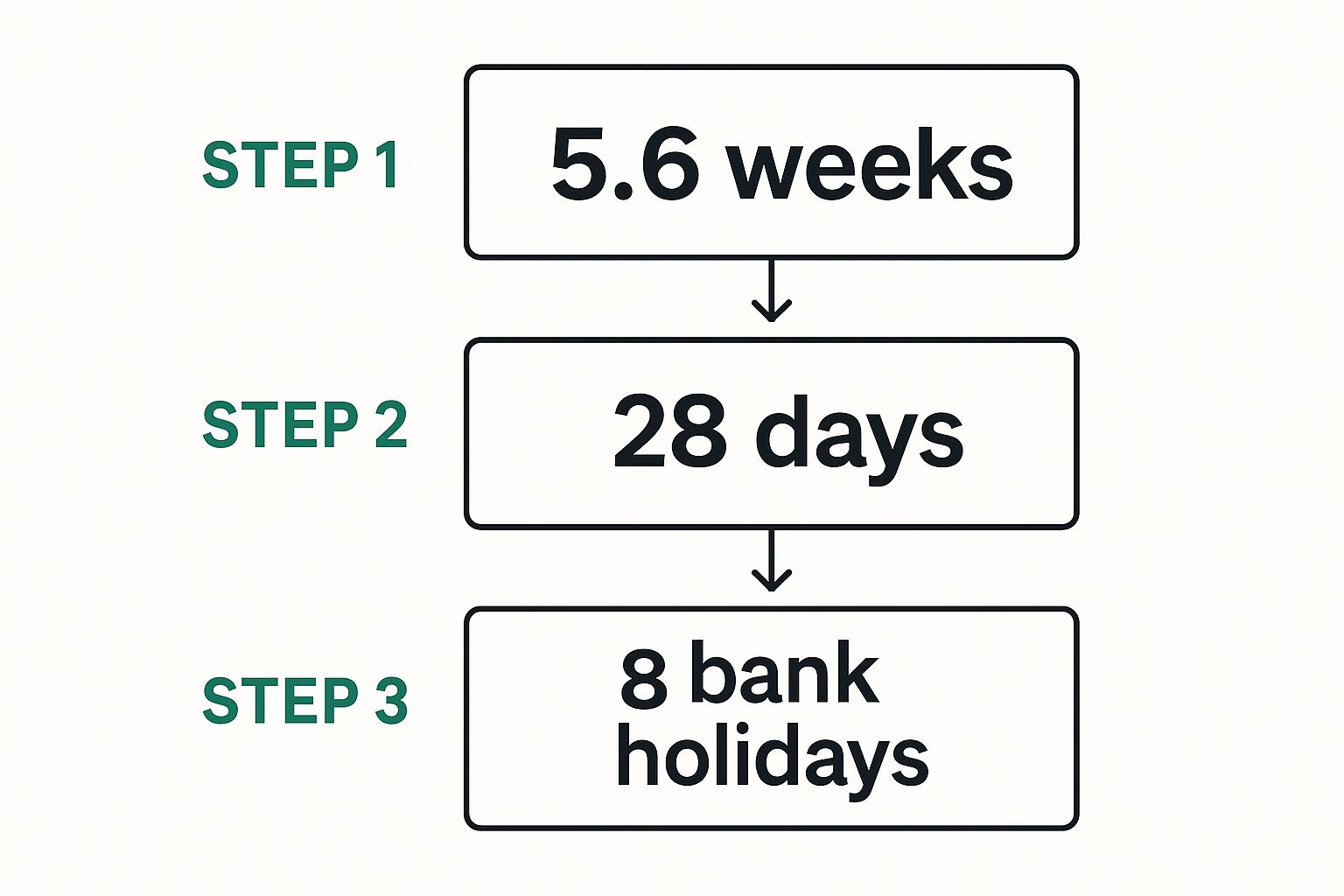
Your Guide to Statutory Holiday Entitlement in the UK
Posted by Robin on 10 Oct, 2025 in
Here in the UK, every employee has a legal right to paid time off. The absolute minimum set by the government is 5.6 weeks per year.
For anyone working a standard five-day week, that translates into 28 days of paid annual leave. Think of it as a fundamental right that ensures nearly every worker gets a mandatory period to rest, recharge, and step away from the daily grind.
Your Fundamental Right to Paid Annual Leave
Understanding your statutory holiday entitlement is one of those non-negotiables for both employees and employers. It's like a personal 'leave account' that the law requires your employer to fund. The baseline is refreshingly simple: almost every type of worker is covered. This includes agency workers, people on zero-hour contracts, and part-time staff.
This isn't just some 'nice-to-have' perk; it’s a legal requirement baked into UK employment law to support employee wellbeing and prevent burnout. It’s the foundation for a healthy work-life balance.
If you want to dig into the official government rules in more detail, our guide to gov.uk holiday entitlement is a great place to start.
What Makes Up the 5.6 Weeks?
So, where does the magic number of 5.6 weeks come from? It's a total figure, but breaking it down makes it much clearer.
For a full-time employee, this 5.6 weeks is typically made up of 20 days of standard annual leave (four weeks) plus the 8 days that often align with UK public or bank holidays. This is where it can get a little confusing, though. Employers have a choice: they can either include these 8 bank holidays within the 28-day minimum, or they can offer them as extra days off on top.
Your employment contract is the ultimate source of truth here. It will spell out exactly how bank holidays are handled – whether Christmas Day and Easter Monday are part of your 28-day allowance or are given in addition to it.
Key Takeaway: Always check your contract! It's the only place you'll find out for sure if bank holidays are included in your 28-day statutory minimum or are given as extra time off. This small detail can be the difference between getting 28 days and 36 days of leave each year.
This infographic breaks down how the core entitlement is calculated.

As you can see, it all flows from that universal 5.6-week rule. This is then converted into days based on a standard work week, with the final piece of the puzzle being how your employer chooses to treat bank holidays.
To make this crystal clear, here’s a simple table showing the standard breakdown for a full-time employee.
Full-Time Statutory Holiday Entitlement at a Glance
| Entitlement Component | In Weeks | In Days |
|---|---|---|
| Standard Annual Leave (Working Time Directive) | 4 weeks | 20 days |
| Additional Leave (UK Regulation) | 1.6 weeks | 8 days |
| Total Statutory Minimum | 5.6 weeks | 28 days |
This table neatly lays out how the 28 days are formed from the initial four weeks of leave plus the additional 1.6 weeks, giving you the complete picture.
Accruing Your Holiday Time
Your holiday allowance doesn't just land in your lap on day one. Instead, it accrues, or builds up, as you work throughout the year. The most common way this works is by accruing one-twelfth of your annual entitlement each month.
Let's look at a quick example. After three months in a new job, a full-time employee would have earned:
- First, the monthly accrual rate: 28 days / 12 months = 2.33 days per month
- Then, multiply by months worked: 2.33 days x 3 months = 7 days of accrued holiday
This system keeps things fair and transparent, especially for people who join or leave a company midway through the holiday year. It gives everyone a clear way to calculate exactly how much leave they're owed at any point. Getting this basic concept down is the first step before we dive into trickier scenarios like part-time work or irregular hours.
Calculating Holiday For Part-Time and Irregular Hours

Not everyone works a neat five-day week, and this is where holiday calculations can feel a little daunting. The good news is, the core principle of 5.6 weeks of paid leave still applies to everyone, no matter their working pattern. The key is simply to apply it proportionally – or 'pro-rata' – to keep things fair.
Think of it like sharing a cake. A full-time employee gets a full slice, which represents their 28 days. A part-time employee gets a smaller slice, but it's still cut from the same cake and is perfectly proportional to the hours they put in. This is how the statutory holiday entitlement in the UK is upheld for every single worker.
Calculating Pro-Rata Holiday for Part-Time Staff
For employees who work a set number of days each week, just fewer than five, the calculation is refreshingly straightforward. The most direct method is to multiply the number of days they work each week by the statutory entitlement of 5.6 weeks.
Let's walk through a common example.
Example: An Employee Working Three Days a Week
An employee who works a consistent three days every week is entitled to a proportional amount of the full-time allowance. The maths looks like this:
- 3 days worked per week x 5.6 weeks = 16.8 days of paid annual leave.
It really is that simple. There’s no complex formula, just a fair application of the universal 5.6-week rule. This ensures a part-time worker receives the same holiday entitlement, in weeks, as their full-time colleagues. For a more detailed look at different scenarios, you can learn more about how to calculate pro-rata holiday in our comprehensive UK guide.
Important Note: When a calculation results in a fraction of a day, like the 16.8 days in our example, you must not round this down. Best practice is to either round it up to the next half or full day (to 17 days, for instance) or allow the employee to take the partial day as time off. For example, they could take a full day off that only uses 0.8 of a day from their allowance.
The Challenge of Irregular and Zero-Hour Contracts
So, what about workers whose hours change every week? This is where the calculation method has to shift. For casual staff or those on zero-hour contracts, holiday entitlement is typically calculated based on the hours they have actually worked.
For many years, the standard approach was the 12.07% method. This percentage represents the proportion of holiday time within a standard working year.
Here's a quick breakdown of how that figure is derived:
- A standard year has 52 weeks.
- The statutory leave is 5.6 weeks.
- This means the typical employee actually works for 46.4 weeks of the year (52 - 5.6).
- When you calculate what percentage 5.6 weeks is of 46.4 weeks (5.6 ÷ 46.4), you get 12.07%.
This means for every hour an employee with irregular hours works, they build up holiday entitlement at a rate of 12.07%. So, if they work 10 hours in one week, they would accrue 1.207 hours of paid holiday (10 hours x 12.07%).
While this method has been widely used, it’s absolutely essential for employers to stay on top of recent legal changes around holiday pay for irregular-hours workers, as official guidance can and does evolve. Accurately tracking hours and applying the correct calculation is vital for staying compliant with UK employment law.
How Bank Holidays Affect Your Annual Leave

Bank holidays often stir up a lot of confusion when it comes to statutory holiday entitlement in the UK. It's a common assumption that these days off are an automatic, legally protected right. The reality, however, is a bit more nuanced and always comes down to one crucial document: your employment contract.
Believe it or not, there's no automatic legal right for an employee to have bank holidays off. The law simply guarantees you 5.6 weeks of paid leave. Your employer can decide whether to include the eight bank holidays (in England and Wales) as part of this total, or if they'll offer them as extra days on top.
Your contract is the ultimate source of truth here. It should clearly spell out whether bank holidays are part of your standard 28-day entitlement or if they are granted in addition, giving you a bit more time off.
What if You Have to Work on a Bank Holiday?
If your contract states you need to work on a bank holiday, your employer still has to make sure you get your full statutory leave. The usual way to handle this is through 'time off in lieu' (TOIL), meaning you get a paid day of holiday to take at another time.
So, if you find yourself working on Christmas Day, your employer owes you another paid day off. This system ensures that even if you're on shift during a public holiday, you don’t lose out on your overall holiday allowance. The specifics of how and when you can take this lieu day should be laid out in your company's holiday policy or your contract.
Here's a common myth: many people think employers have to pay extra for working on a bank holiday, like 'time and a half'. While many companies do offer better pay as a nice perk, there's no legal requirement for them to do so unless it's written into your employment contract.
Sometimes, the number of bank holidays in a leave year changes, which can affect how leave is managed. For instance, there were fewer bank holidays between April 2024 and March 2025, which might have meant fewer total days off unless a company chose to offer more. Employers had to double-check their contracts to make sure they were still meeting the 28-day statutory minimum. You can dig into the details of how businesses should handle these changes over on brabners.com.
Ensuring Fairness for Part-Time Workers
When it comes to part-time staff, the principle of pro-rata entitlement is absolutely vital for fairness. A part-timer shouldn't be penalised just because a bank holiday happens to fall on a day they don't typically work. The right way to do it is to calculate their bank holiday entitlement proportionally.
Here’s a practical breakdown of how that works:
- Step 1: Start with the full-time equivalent holiday entitlement (e.g., 28 days, which includes 8 bank holidays).
- Step 2: Work out the part-timer's pro-rata entitlement based on their working days. For someone working 3 days a week, this comes out to 16.8 days (3 ÷ 5 x 28).
- Step 3: If a bank holiday falls on one of their normal working days, they take it off, and it's deducted from their 16.8-day allowance.
- Step 4: If a bank holiday is on a day they don't work (like a Monday for someone who works Tuesday-Thursday), they don't miss out. That day is still part of their accrued 16.8-day entitlement, which they can book off at another time.
This approach makes sure every employee receives their full 5.6 weeks of leave, no matter which days of the week they work. It's all about maintaining fairness across the whole team.
Untangling Holiday Carry-Over and Booking Rules
What happens to your holiday allowance when the year ticks over? It’s a classic workplace question, and the answer isn't always a straightforward "use it or lose it." Getting to grips with the rules around carrying holiday over is a massive part of managing your statutory holiday entitlement in the UK.
As a general rule, the first four weeks of your statutory leave (a legacy from the EU's Working Time Directive) have to be taken in the year you earn them. This is a core protection to make sure every worker gets a proper break. But that's not the end of the story.
The final 1.6 weeks of your entitlement (which works out to 8 days for a full-timer) can sometimes be carried forward. This is only an option if there’s a clear agreement between you and your employer, something that should be spelled out in your employment contract or company handbook.
The Rules on Carrying Over Unused Leave
While the standard guidance is pretty firm, there are some really important exceptions where the law is much more flexible. These situations usually pop up when you've been unable to take your holiday for reasons completely out of your control.
The biggest exceptions are for long-term sickness or family-related leave.
Long-Term Sickness: If you’re off on long-term sick leave and can't possibly take your holiday, you are legally allowed to carry over up to four weeks of your statutory leave. The catch is that you must use this carried-over leave within 18 months of the end of the holiday year it was earned in.
Family Leave: It's a similar story if you're on maternity, paternity, adoption, or shared parental leave. You still build up your holiday entitlement during this time, but since you can't take it, any unused statutory leave must be carried over to the next holiday year.
These rules act as a safety net, ensuring people don't lose their fundamental right to paid time off just because of illness or for starting a family.
Key Insight: At its heart, the law protects your right to paid rest. If you're blocked from taking your full statutory holiday because of long-term sickness or family leave, the rules bend to make sure you don't lose that time.
This framework is there for protection, but it’s always better for everyone if employers and employees talk openly about booking leave to stop large amounts from piling up in the first place.
Booking Your Holiday and What Happens if it's Refused
Beyond carrying leave over, the day-to-day practicalities of actually booking time off are governed by their own set of rules. You can't just decide to take a holiday tomorrow; there's a process involving notice periods and getting the green light from your employer.
To manage staffing and keep the business running smoothly, your employer can ask you to give a certain amount of notice before you take any leave.
The Rule of Thumb for Notice:
Requesting Leave: You need to give notice that is at least twice as long as the holiday you want to take. For example, to book a one-week holiday (five working days), you’d need to give at least two weeks' notice.
Refusing Leave: An employer can say no to a holiday request, but they must have a good reason and give you notice that's at least as long as the leave you asked for. So, to turn down a request for a one-week holiday, they have to let you know at least one week in advance.
An employer can only refuse a request on reasonable business grounds. This might be because it's a crazy busy period, you're up against a major project deadline, or too many other people are already off. It can’t be used as a tool to unfairly stop you from ever taking your holiday. Clear communication and a fair, transparent company policy are the best ways to avoid any arguments over booking time off.
Calculating Holiday Pay When Leaving a Job

Navigating your final weeks at a company is all about tying up loose ends for a clean, professional exit. A massive part of this is making sure you get paid correctly for any holiday you’ve earned but haven’t had a chance to take. Getting this calculation right ensures your final payslip is accurate and you walk away with everything you're legally owed.
The whole thing works on the same pro-rata principle we've been talking about. You're entitled to payment for whatever slice of your statutory holiday entitlement in the UK you've earned right up to your last day. This is a key protection that stops employees from losing out on the leave they've rightfully built up.
The Simple Formula for Final Holiday Pay
So, how do you work out what you’re owed? It’s a straightforward process. First, you figure out what fraction of the holiday year you’ve actually worked. From there, you calculate the proportional holiday for that period and then just subtract any days you’ve already taken off.
Let's walk through it with a full-time employee who gets the standard 28 days of annual leave. We'll say their company's holiday year is January to December, and they're leaving at the end of June.
- Calculate the proportion of the year worked: They've been on the payroll for 6 out of 12 months, which is exactly 50% of the holiday year.
- Calculate accrued holiday: Now, multiply their full entitlement by that percentage: 28 days x 50% = 14 days.
- Subtract leave already taken: If they've already used 5 days of holiday, they are owed payment for what's left: 14 days - 5 days = 9 days.
Their final payslip should include payment for those nine unused, accrued days. For a deeper dive into different scenarios, check out our detailed guide on https://blog.leavetrackapp.com/articles/holiday-entitlement-when-leaving-a-job.
A Crucial Point on Pay Rate: That final holiday payment isn't just your basic salary. The law says it must reflect your 'normal' pay. That means if you regularly earn overtime, commission, or bonuses, that has to be factored in to accurately mirror what you would have earned.
For businesses trying to nail these calculations every time, especially with the complexities of final pay, bringing in expert managed payroll services can be a game-changer.
What If You Have Taken Too Much Holiday?
Of course, the shoe can sometimes be on the other foot. An employee might use up more holiday than they’ve actually accrued by the time they leave. Imagine someone takes a two-week holiday in February and then hands in their notice in March.
In this situation, an employer can legally deduct the value of the extra holiday from the employee's final salary. There's a big 'but', though: this is only allowed if there is a specific clause in the employment contract that explicitly says they can.
If that clause isn't in the contract, the employer has no right to reclaim the money. This really highlights how important a clear, well-drafted employment contract is. It needs to cover all eventualities to protect both the business and the employee from financial headaches during offboarding. Transparency from day one is always the best policy.
Common Holiday Entitlement Myths Debunked
There's a lot of misinformation floating around about statutory holiday entitlement in the UK. This confusion can easily spiral into workplace disputes, so let's clear the air. We'll tackle some of the most common myths, separating the fiction from the legal facts.
Getting this right is crucial. While many companies have generous leave policies, a surprising number of employees don't take all their time off, leaving an average of about five days unused each year. You can find more insights into these annual leave trends from timetastic.co.uk. This makes clarifying the baseline rules even more important.
Myth 1: Bank Holidays Are an Automatic Extra Day Off
This is probably the most stubborn myth of them all. It's a widespread belief that everyone automatically gets bank holidays off with pay, but that’s not how the law works.
Reality: There’s no automatic legal right to have bank holidays off. Your employer can absolutely require you to work on one. The law simply guarantees a minimum of 5.6 weeks of paid leave per year. Your employment contract is the key document here – it will specify whether the eight bank holidays (in England and Wales) are included within that total or are given on top.
Myth 2: Zero-Hour Contract Workers Don't Get Paid Holiday
Another classic misconception is that people on zero-hour or casual contracts miss out on paid holiday simply because their hours aren't fixed.
Reality: This is completely untrue. Workers on zero-hour contracts build up holiday entitlement just like any other employee. Their leave is calculated on a pro-rata basis, typically pegged to the hours they’ve actually worked. For every hour on the job, they accrue a portion of paid leave, ensuring they receive their fair slice of the 5.6-week statutory entitlement.
The Core Principle: UK employment law is designed to be inclusive. It doesn't matter if you're full-time, part-time, or on a zero-hour contract—almost every worker has a right to paid annual leave. The calculation method might change, but the fundamental right doesn't.
Myth 3: A 'Use-It-or-Lose-It' Policy Is Always Legal
Many companies have a "use-it-or-lose-it" policy, where untaken holiday disappears at the end of the leave year. While this is often the case, it’s not an absolute rule and comes with some very important legal exceptions.
Reality: A "use-it-or-lose-it" approach is generally lawful for the 1.6 weeks of additional statutory leave, as long as it's clearly laid out in the contract. However, the first four weeks of statutory leave are more protected. This core entitlement can't be carried over unless an employee was genuinely unable to take it due to specific circumstances, like being on long-term sick leave or statutory family leave (maternity, for example). In these situations, the law steps in to ensure an employee doesn't lose their fundamental right to rest.
Your Holiday Entitlement Questions, Answered
When it comes to statutory holiday entitlement in the UK, the theory is one thing, but the day-to-day reality often throws up some tricky questions. Let's tackle some of the most common queries we see from both employers and employees.
Can My Employer Dictate When I Take My Holiday?
Yes, they can, within reason. It’s quite common in certain industries for a company to have a fixed shutdown period, like a factory closing for a week over Christmas. Your employer can require you to take some or all of your annual leave during this time.
The key is that they have to give you proper notice. The rule of thumb is double the length of the leave. So, if they want you to take one week off, they must tell you at least two weeks beforehand. This should always be clearly laid out in your employment contract or company handbook, so there are no surprises.
What Happens to My Holiday If I'm Made Redundant?
If you're made redundant, you're legally entitled to be paid for any statutory holiday you've earned but haven't taken. This payment for your untaken, accrued leave should be part of your final payslip.
The calculation is done on a pro-rata basis, just as if you were leaving voluntarily. Crucially, the payment must be at your normal rate of pay, which includes any regular overtime or commission you typically earn. This ensures you get the full value of the holiday time you're owed.
Key Takeaway: Redundancy doesn't erase your right to accrued holiday pay. It's a legal entitlement that must be settled in your final payment, based on how much of the leave year you've worked.
Do I Still Accrue Holiday While on Sick Leave?
Absolutely. You continue to build up your statutory holiday entitlement even when you're off sick. This applies no matter how long you're away from work; your right to paid annual leave is protected.
If you're on long-term sick leave and can't use your holiday in the current leave year, you can carry over up to four weeks of it. This carried-over holiday must then be taken within 18 months of the end of the leave year it was accrued in. It's a vital protection that makes sure illness doesn't rob you of your right to a paid break.
Is My Employer Allowed to Pay Me Instead of Letting Me Take Holiday?
This is a big one, and the answer is almost always no. The law is very firm on this: the first four weeks of your statutory annual leave must be taken as actual time off. It's seen as a health and safety measure to make sure you get proper rest.
The only exception is when your employment ends. At that point, your employer must pay you for any accrued but unused portion of your full 5.6 weeks entitlement in your final salary.
Managing leave requests, accruals, and staying compliant can be a real headache. Leavetrack replaces messy spreadsheets with a simple, clear system for planning and approving staff holiday, ensuring everyone gets the time off they're entitled to. Learn more about how you can simplify your absence management at Leavetrack.
